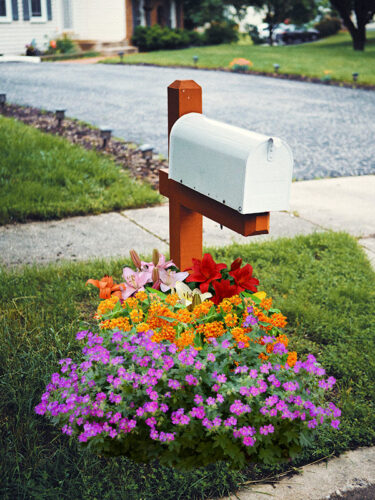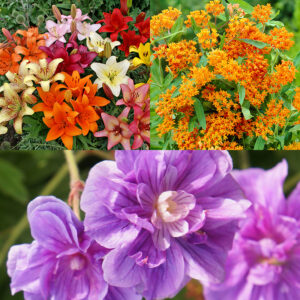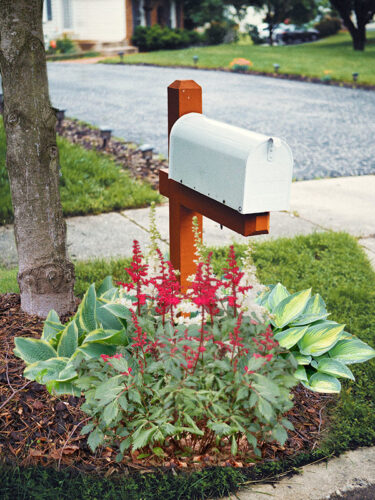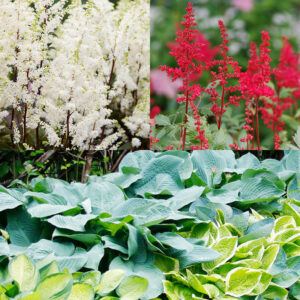Creating a good first impression in life is essential. When a visitor comes to your home the first thing they see can leave a lasting impression. Commonly the first thing a guest notices on your property is the entryway which often includes the mailbox. Upon entering, the mailbox may display your address or is located at the end of the driveway. Therefore, to create a lasting impression on new house guests (and your mail carrier) take care to make an appealing mailbox garden.
If you are looking for inspiration on what to plant around your mailbox you’re in luck! Continue reading for helpful information on two mailbox garden design ideas. Each garden includes details of what to plant and where to plant.
Mailbox Garden Design for Sun
Easy to grow summer flowers make this mailbox garden appealing. The perennials in this garden will be bursting with color from early to late summer. Included in the plan are low-maintenance bulbs and perennials.
Sunny Perennial Mailbox Garden Plants
The first flowers to bloom in the Mailbox Garden for Sun are the Butterfly Weed. They will bloom in profusion in early summer, and then sporadically throughout the summer. Butterfly Weed is one of the best perennials for attracting butterflies. It will grow in a tall v-shaped form and grows 18-36″ tall.
Next to bloom are the Mixed Asiatic Lilies, they will bloom in early to mid-summer. Mixed Asiatic Lilies bloom in an array of warm colors including, red, orange, yellow, and pink. They have an upright habit and are the tallest plant in this mailbox garden, reaching heights of 36-42″.
The Birch Double Cranesbill blooms starting in early summer and continues to flower throughout the season until late summer. Cranesbill are versatile perennials that tend to have a long bloom time, and also have attractive foliage colors in fall. Birch Double Cranesbill has a sprawling habit that will fill in the front of the planting area in this mailbox garden.
Sunny Perennial Mailbox Garden Design Details:
Plant the bulbs and perennials in this mailbox garden in spring or early summer. The plants in this mailbox garden are not sensitive to frost. However, planting in soil that is too cold in early spring could be problematic. The ideal planting conditions are when the daytime temperatures are above 55 degrees on a consistent basis.
This mailbox garden for the sun is designed as a circle-shaped planting area. The bulbs and perennials will all be planted around the mailbox. This will allow the flowers to be enjoyed from all angles. The planting area for this mailbox garden should receive at least 6 hours of sun per day.
Bulbs and Perennials Needed:
Sunny Perennial Mailbox Garden Planting Steps
- Map out and dig out the planting area. This garden is designed for a circle shape around the mailbox that is 3′ in diameter. This means that the planting bed will be 3′ across from one side to the other. Remove any grass in the planting area so the bulbs and perennials can be planted in bare soil.
- Remove the Mixed Asiatic Lilies from their package. Place the 8 bulbs around the post of the mailbox. The bulbs should be 3-6″ from the post of the mailbox. Space each bulb 6-9″ from each other. The lily bulbs should be placed in a circular pattern around the post.
- Remove the Butterfly Weed roots from the package. Place each root approximately 12″ from the lily bulbs in a staggered pattern. They should be 12″ from each other forming a triangle shape. The butterfly weed will be in the middle of the planting bed on each side of the mailbox.
- Remove the Birch Double Cransebill roots from the package. Place each root approximately 12″ from the butterfly weed, in a staggered pattern. The cranesbill will be planted in front of and in between each butterfly weed. They will be in the front of the planting bed on each side of the mailbox.
- Now that the roots have been placed where they will be planted, it’s time to plant. Start planting from the outside working your way to the inside of the circle.
How to Plant the Sunny Perennial Mailbox Garden
- Plant the Birch Double Cranesbill at a depth of 1-2″. Dig into the soil and spread the roots out. The crown of the plant which is where all the roots come together should be at the soil surface level or slightly above the soil level. Once the roots are in the ground cover them up with the soil you removed from the planting area.
- The Butterfly Weed root will be long and skinny, looking somewhat like a small carrot. Dig the planting hole deep enough so the root can fit. The crown of the root should be at or above the soil surface. Once the roots are in the ground cover them up with the soil you removed from the planting area.
- Plant the Mixed Asiatic Lilies 6-8″ deep. Dig a hole for each bulb and place the bottom of the bulb 6-8″ deep into the soil. The pointed end of the bulb should be facing up. Once the bulb is in the planting hole cover each bulb up with the soil that was removed from the planting area.
- Water the entire planting area to help settle any air pockets in the soil.
- Apply a 2-3″ thick layer of natural mulch, such as hardwood mulch or hemlock to the planting area. Mulch helps to regulate the soil temperatures, control moisture, and keep weed growth down.
Mailbox Garden Design for Shade
Create a garden with texture and color for a mailbox located in shade. Whether the planting location has dappled sun from trees or full shade, the perennials in this design will create color all summer. Included in the plan are shade-loving perennials that are low maintenance and will return for several years.
Shady Perennial Mailbox Garden Plants
The hostas included are a mix of different leaf colors and shapes. The height and shape of the hosta plants also vary, which helps create texture and dimension. They act as an anchor to the showy astilbe flowers. Hostas are easy to grow perennials and tolerate very heavy shade as well as lightly filtered shade.
Starting in the mid-summer both varieties of astilbe will begin to bloom. Bridal Veil Astilbe blooms with pure white flowers, while the Fanal Red Astilbe bloom with deep raspberry-red flowers. Astilbe has an upright habit with wispy flowers. The delicate and finely cut leaves of the astilbe will contrast and compliment the bold hosta leaves.
Shady Perennial Mailbox Garden Design Details
This mailbox garden for shaded areas is designed in a circle shape. Plant the perennials in this mailbox garden in spring or early summer. The ideal planting conditions are when the daytime temperatures are above 55 degrees on a consistent basis.
Astilbe require moisture to thrive, therefore, it is important that they are watered on a consistent basis, especially during the first 1-2 years after planting. Hosta plants also like moist soil but aren’t as sensitive to dry conditions as astilbe.
Perennials Needed:
Shady Perennial Mailbox Garden Planting Steps
- Map out and dig out the planting area 3′ diameter planting area. Strip any grass away from the planting area prior to planting.
- Remove the Mixed Hosta roots from the package. Place three roots on each side of the mailbox in a staggered pattern, forming a triangle shape. Space each hosta root 12″ from each other.
- Remove the Bridal Veil Astilbe roots from the packages. Place three roots on both sides of the mailbox post in a staggered pattern, forming a triangle shape. Space each Bridal Veil Astilbe 12″ from each other, and 3-4″ from the mailbox post.
- Take the Fanal Red Astilbe roots out of the package. Lay three roots near the front edge of the planting bed on both sides of the mailbox in a staggered pattern. Fanal Red Astilbe should be spaced 12″ from each other.
- Start planting from the outside working your way to the inside of the circle.
How to Plant the Shady Perennial Mailbox Garden
- Plant the Fanal Red Astilbe at a planting depth of 1-2″. The crown of the plant where all the roots come together should be at the soil level or slightly above.
- Plant the Bridal Veil Astilbe at a planting depth of 1-2″. The crown of the plant where all the roots come together should be at the soil level or slightly above.
- Plant the Mixed Hosta at a planting depth of 1-2″. The crown of the plant where all the roots come together should be at the soil level or slightly above.
- Water the entire planting area this helps to moisten the roots and settle air pockets in the soil.
- Apply a 2-3″ thick layer of mulch over the bare soil Mulch regulates the soil temperatures, controls moisture and prevents weeds from growing.
Easy to Grow Summer Blooming Mailbox Gardens
Create an inviting entry starting with your mailbox. Whether the mailbox is in the sun or shade the plants included in both designs will create plenty of curb appeal. Both of these designs are a great start to inspiring a colorful and vibrant mailbox garden, be creative in making it work best for you!
One final note:
Modify the plan if the planting area does not allow for a circle-shaped garden. A half-circle can be created on one side of the mailbox, and the plantings can be doubled on that side. If a square-shaped garden matches your property better, the mailbox gardens will work for that shape too.






